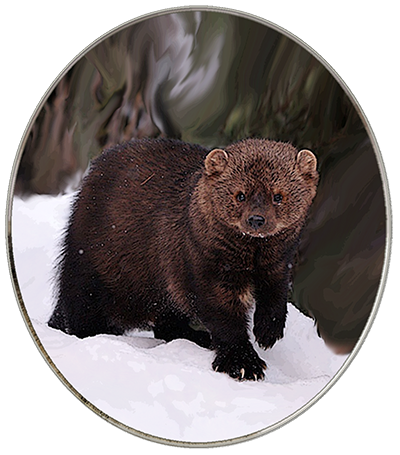Fisher
They are sometimes called 'fisher cats' but this term is incorrect. The fisher is a small (about the size of a large house cat), but fearless carnivorous mammal of the mustelid (not feline) family, with the long body, short legs, a short nose, small round ears, and well developed sub-caudal scent glands that serve various functions.
Their fur consists of two 'layers' - a thick, dense undercoat with longer, coarser guard hairs on top. Fur color varies from dark brown to nearly black, with females and juveniles having a more uniform color overall and males sporting a more grizzled appearance due to multi-colored guard hairs around the neck, upper back, and shoulders. 
"Fishers inhabit upland and lowland forests, including coniferous, mixed, and deciduous forests. They occur primarily in dense coniferous or mixed forests, including early successional forest with dense overhead cover (Thomas 1993). They generally avoid areas with little forest cover or significant human disturbance. The Fisher is adapted for climbing but is primarily ground-dwelling. It is a generalized predator with major prey of small to medium-sized mammals and birds, and carrion (Powell 1981)."
The fisher population declined during the 19th and wearly 20th centuries because of excessive fur trapping and habitat destruction through logging. Their skins were valuable, they were easy to trap year-round. Logging fragments fisher habitat and the planted regrowth is typically a single tree type of the same age, suited more for future logging rather than for replenishing a natural forest with varied growth stages of multiple species - rendering the new forest unsuitable for fisher populations as well as many other wildlife species. Optimal conditions for fishers are fest tracts of 100 ha or more, interconnected with other large areas of suitable habitat. Fishers will also vary their habitat use, often travelling extensively within their habitat. In the winter they prefer old coniferous forest with plenty of canopy cover but in summer are more likely found in hardwood stands.
Fishers are solitary, crepuscular (most active in the laste evening and very early morning) predators that prey mostly upon small to medium sized mammals and birds, with a special penchant for hares. They will also kill and eat porcupines, biting in the face to kill and then eating from the underside. They eat the entire animal, leaving only a quilled hide and a few of the larger bones. They are mostly carnivorous as well as opportunistic feeders, but will eat berries and fruit.
West Coast fisher population was proposed for federal listing as a threatened species in late 2014. (In 2015, the southern Sierra Nevada population was listed as threatened under the California Endangered Species Act.) As of April of 2016, the Oregon Fish and Wildlife Service lists fishers as a sensitive species in the critical category. It is also listed as a protected non-game species.
Threats
- Trapping
- Timber cutting
- There is a growing number of deaths from vehicle collision.
- There are a growing number of reports of fisher deaths due to rat poison commonly used on marijuana farms. The poisons, anticoagulant rodenticides, act by interfering with liver synthesis of vitamin K-dependent blood-clotting factors and damaging the small blood vessels. Symptoms of anticoagulant exposure are bleeding from the nose and gums, extensive bruises, anemia, fatigue, behavioral changes, and difficulty breathing.
- Natural predators include man and ocassionally bobcats.
Quick Facts
- Dimorphism between the sexes - males weighing between 7 and 13 pounds and females between 3 - 7 pounds.
- Average length is 35 - 47 inches for males and 30 - 37 inches for females, including a tapering 12 - 16 inch tail.
- Large, wide feet with five toes on each foot and semi-retractable claws. They are capable of rotating their hind feet nearly 180 degrees, which allows a headfirst descent from trees.
- Both sexes have anal glands that secrete a heavy musk scent.
- Found exclusively in North America in forested and semi-forested land, preferring extensive closed canopy forests.
- Reproductively mature at as young as one year, implantation of fertilized embryo may be delayed until the following season, accounting for the first litter being born in their second year.
- Average litter size is 2 - 3 young.
- Young are called kits.
Sources
N.a. "." Eolss.net. 5 Oct. 2011. Web. 2 Dec. 2016. <https://www.eolss.net/Sample-Chapters/C06/E6-52-06-01.pdf>
Nowak, R. 1991. Carnivora: family Mustelidae. Pp. 1104-1105 in Walker's Mammals of the World, Vol. 2, 5th Edition. Baltimore: Johns Hopkins University Press.
Encyclopedia of Life. "Weasel Family - Mustelidae - Details - Encyclopedia of Life." Encyclopedia of Life. n.d. Web. 2 Dec. 2016. <http://eol.org/pages/7670/details>
Matt Wund. "Mustelidae (badgers, otters, weasels, and relatives)." Animal Diversity Web. n.d. Web. 2 Dec. 2016. <http://animaldiversity.org/accounts/Mustelidae/>
N.a. "Saving Wildlife | Pacific Southwest Region." Fws.gov. n.d. Web. 2 Dec. 2016. <https://www.fws.gov/cno/es/fisher/>
N.a. "Mustelids: The Weasel Family - AllAboutNature.com." Enchantedlearning.com. 31 Aug. 2004. Web. 2 Dec. 2016. <http://www.enchantedlearning.com/subjects/mammals/weasel/Mustelids.shtml>
Helgen, K. & Reid, F. 2016. Martes pennanti. The IUCN Red List of Threatened Species 2016: e.T41651A45213362. <http://dx.doi.org/10.2305/IUCN.UK.2016-1.RLTS.T41651A45213362.en>
N.a. "." Natureindeed.com. 31 Jan. 2014. Web. 2 Dec. 2016. <http://www.natureindeed.com/PDFs/Fisher_Fact_Sheet.pdf>
Mass Audubon. "About Fishers." Mass Audubon. n.d. Web. 2 Dec. 2016. <http://www.massaudubon.org/learn/nature-wildlife/mammals/fishers/about>
UC Davis. "Rat poison at marijuana farms is killing increased numbers of rare forest mammal." UC Davis. 4 Nov. 2015. Web. 2 Dec. 2016. <https://www.ucdavis.edu/news/rat-poison-marijuana-farms-killing-increased-numbers-rare-forest-mammal>
Bridget Callahan. "Threatened: Get to know the Pacific Fisher | Oregon Wild." Oregonwild.org. n.d. Web. 2 Dec. 2016. <http://www.oregonwild.org/about/blog/threatened-get-know-pacific-fisher>
N.a. "Fisher - NYS Dept. of Environmental Conservation." Dec.ny.gov. n.d. Web. 2 Dec. 2016. <http://www.dec.ny.gov/animals/9357.html>
Mourad W. Gabriel. "Patterns of Natural and Human-Caused Mortality Factors of a Rare Forest Carnivore, the Fisher (Pekania pennanti) in California." Journals.plos.org. n.d. Web. 2 Dec. 2016. <http://journals.plos.org/plosone/article?id=10.1371/journal.pone.0140640>
U.s. Fish & Wildlife Service. "OFWO - Fisher." Fws.gov. n.d. Web. 2 Dec. 2016. <https://www.fws.gov/oregonfwo/articles.cfm?id=149489430>
